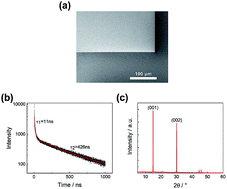Low-threshold room-temperature continuous-wave optical lasing of single-crystalline perovskite in a distributed reflector microcavity†
Abstract
Organic–inorganic halide perovskites have achieved remarkable success in various optoelectronic devices. A high-quality CH3NH3PbBr3 single-crystalline thin film has been directly grown in a micrometer gap between a pair of distributed reflectors with over 99.9% reflectivity, which naturally form a vertical cavity surface-emitting laser device with a single mode or several modes. The single-crystalline perovskite has an exciton lifetime of 426 ns and evidence of the exciton–photon coupling is observed. At room temperature and under continuous-wave optical pumping conditions, this device lases at a threshold of 34 mW cm−2 in the green gap. The extremely low lasing threshold suggests that polariton lasing may occur in the strongly confined optical cavity comprising the high-quality single-crystalline perovskite.



 Please wait while we load your content...
Please wait while we load your content...